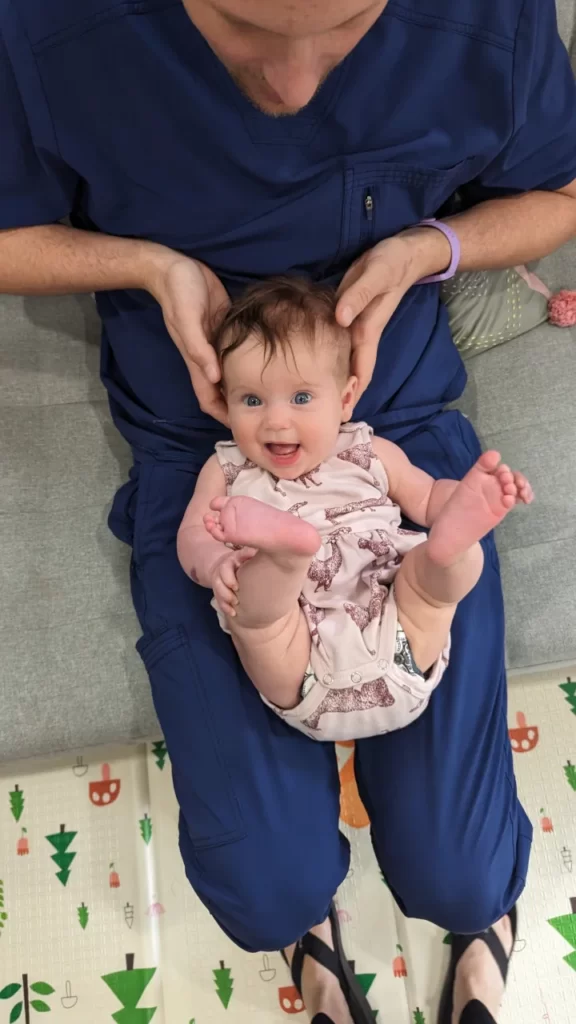Introduction
Torticollis, a condition that affects the muscles of the neck, is often associated with adults. However, it can also occur in infants and children, leading to a range of complications if left untreated. Pediatric torticollis, also known as infant torticollis, is a condition where a baby’s head is persistently turned to one side, resulting in a limited range of motion and asymmetrical development of the neck muscles.
The causes of pediatric torticollis can vary, but most commonly it is due to tightness or weakness in the neck muscles. In some cases, it can be caused by positioning in the womb or during birth, an injury to the neck, or a medical condition.
Early intervention is critical in the management of pediatric torticollis. Physical therapy for torticollis can help improve the range of motion in the neck, reduce pain and discomfort, and prevent the development of secondary complications such as plagiocephaly (flat head syndrome).
Physical therapy for torticollis typically includes a combination of stretching exercises, strengthening exercises, manual therapy, postural training, and parent education. The goal is to promote normal development of the neck muscles and prevent long-term consequences that may impact the child’s quality of life.
Parents and caregivers play a crucial role in the management of pediatric torticollis. They must work closely with their child’s healthcare team to ensure that the child receives the appropriate care and follow through with home exercises and other interventions. With early intervention and proper treatment, children with torticollis can achieve optimal neck function and development, leading to a better quality of life.
Assessment
Assessment is an important component of physical therapy for torticollis. The initial evaluation of a child with torticollis involves a comprehensive assessment of the child’s medical history, physical examination, and developmental assessment. The assessment is critical in determining the severity of the torticollis, identifying any underlying medical conditions, and developing a personalized treatment plan.
During the physical examination, the therapist will assess the range of motion of the neck and identify any asymmetry in the neck muscles. This can be done through observation, palpation, and measurements. In addition, the therapist will evaluate the child’s head shape and posture to identify any potential complications such as plagiocephaly or scoliosis.
The developmental assessment is also a critical part of the evaluation process. The therapist will evaluate the child’s motor skills, including gross motor and fine motor skills, to determine any delays or deficits. This helps the therapist understand the child’s functional limitations and tailor the treatment plan accordingly.
In addition to the physical examination and developmental assessment, the therapist will also review the child’s medical history to identify any underlying medical conditions that may be contributing to the torticollis. This may involve reviewing any medical records, consulting with the child’s pediatrician, and conducting additional tests if necessary.
Overall, the assessment of pediatric torticollis is a comprehensive process that involves a thorough evaluation of the child’s medical history, physical examination, and developmental assessment. This information is used to develop a personalized treatment plan that addresses the child’s specific needs and goals. It’s important to note that the assessment should be conducted by a licensed physical therapist who specializes in pediatric care to ensure the best possible outcomes for the child.

Goals Of Physical Therapy For Torticollis
The goals of physical therapy for pediatric torticollis are multifaceted and aim to address the child’s specific needs and goals. The primary goals of physical therapy for torticollis in infants and children are:Improve range of motion: One of the primary goals of physical therapy for torticollis is to improve the range of motion in the neck muscles. This is done through a combination of stretching exercises, manual therapy, and postural training. The therapist will work with the child to gradually increase their range of motion and improve their ability to move their head freely.
- Reduce pain and discomfort: For some babies torticollis can cause pain and discomfort. Physical therapy for torticollis can help these symptoms to relax the muscles. This allows for improved muscle function, less tension, and reduction in pain/discomfort.
- Prevent the development of secondary complications: Torticollis can lead to plagiocephaly (flattening of head), scoliosis, and developmental delays. Physical therapy can help prevent the development of these complications by addressing the reasons behind torticollis.
- Improve gross motor skills: Torticollis can slow the development of gross motor skills, including sitting, crawling, and walking. Physical therapists can support this area by promoting appropriate movements and developing improved strategies of movement.
Overall, physical therapy for torticollis promotes normal development of the neck muscles, prevents secondary complications, and improves the child’s gross motor skills. The therapist will work with family and child to develop a personalized treatment plan that addresses their goals and ensures the best possible outcomes.

Treatment For Pediatric Torticollis
The treatment plan for pediatric torticollis typically involves a combination of stretching exercises, manual therapy, postural training, and environmental modifications. The specific interventions used will depend on the child’s individual needs and goals, as determined through the assessment process.
- Stretching exercises: Stretching exercises are used to increase the range of motion in the neck muscles and improve the child’s ability to move their head freely. The therapist will work with the child and their caregivers to develop a stretching routine that can be done at home on a daily basis.
- Manual therapy: Manual therapy techniques such as massage, myofascial release, and joint mobilization may be used to help release tension in the neck muscles and improve range of motion. These techniques are typically performed by the therapist during therapy sessions.
- Postural training: Postural training involves teaching the child and their caregivers how to maintain proper alignment of the head and neck during everyday activities. This may involve positioning the child in certain ways during feeding, play, and sleep, and providing them with supportive devices such as pillows or rolls.
- Environmental modifications: Environmental modifications may be necessary to prevent the child from favoring one side of the body or head. This may involve adjusting the height of furniture, using a specialized car seat or stroller, or providing the child with a supportive device such as a headband or neck brace. We have a list to start with to support your child before an appointment.
- Parent education: Parent education is an important component of the treatment plan. The therapist will work with the child’s caregivers to educate them on the condition, the treatment plan, and strategies for promoting normal development.
The frequency and duration of physical therapy sessions will depend on the child’s individual needs and goals. In general, infants with torticollis require more frequent therapy sessions, often up to three times per week, while older children may only require one or two sessions per week. The duration of treatment will depend on the severity of the torticollis and the child’s response to therapy. In some cases, treatment may continue for several months or even up to a year.
In summary, the treatment plan for pediatric torticollis involves a combination of stretching exercises, manual therapy, postural training, environmental modifications, and parent education. The goal of the treatment plan is to promote normal development of the neck muscles, prevent the development of secondary complications, and improve the child’s functional abilities. The therapist will work closely with the child and their caregivers to develop a personalized treatment plan that addresses their specific needs and goals.
Collaborative Care
Collaborative care is an essential component of the treatment plan for pediatric torticollis. The multidisciplinary team involved in the care of a child with torticollis may include a pediatrician, physical therapist, occupational therapist, speech-language pathologist, and orthotist, among others. The team will work collaboratively to ensure that the child receives comprehensive, coordinated care that addresses all aspects of their condition.
- Pediatrician: The pediatrician is typically the first healthcare provider to evaluate a child with torticollis. They may refer the child to a physical therapist or other specialist for further evaluation and treatment. The AAP recommends many of the treatments outlined in this article. The pediatrician will continue to oversee the child’s overall care and may provide medical interventions as needed.
- Physical therapist: The physical therapist plays a crucial role in the management of pediatric torticollis. They are responsible for assessing the child’s neck mobility, developing a treatment plan, and providing interventions to improve range of motion and prevent secondary complications. The physical therapist will work collaboratively with the child’s caregivers to ensure that the treatment plan is being followed and adjusted as needed.
- Occupational therapist: The occupational therapist may be involved in the care of a child with torticollis if they have difficulty with fine motor skills or activities of daily living. The occupational therapist can provide interventions to improve hand-eye coordination, grasp and release, and other fine motor skills.
- Speech-language pathologist: The speech-language pathologist may be involved in the care of a child with torticollis if they have difficulty with feeding or swallowing. They can provide interventions to improve oral motor skills and ensure that the child is able to feed safely and effectively.
- Orthotist: The orthotist may be involved in the care of a child with torticollis if they require a headband or neck brace to support their neck and promote proper alignment. The orthotist will work with the physical therapist to ensure that the orthotic device is properly fitted and effective in achieving the desired outcomes.
Collaborative care is essential for ensuring that the child receives comprehensive, coordinated care that addresses all aspects of their condition. The multidisciplinary team will work closely together to develop and implement a treatment plan that addresses the child’s individual needs and goals. Communication among team members is key to ensuring that the child’s care is well-coordinated and that interventions are consistent across settings.
In conclusion, collaborative care is an essential component of the treatment plan for pediatric torticollis. The multidisciplinary team involved in the care of a child with torticollis will work together to ensure that the child receives comprehensive, coordinated care that addresses all aspects of their condition. Communication among team members is key to ensuring that the child’s care is well-coordinated and that interventions are consistent across settings.

Conclusion
In conclusion, pediatric torticollis is a condition that can significantly impact a child’s quality of life if left untreated. Physical therapy plays a crucial role in the management of this condition, with the goals of improving neck range of motion, preventing secondary complications, and promoting normal development. Assessment, goal-setting, treatment planning, collaborative care, and progress monitoring are all key components of effective physical therapy for torticollis.
It is important for healthcare providers to work collaboratively with the child’s caregivers to ensure that the treatment plan is well-coordinated and consistent across settings. Regular progress monitoring allows for adjustments to be made to the treatment plan as needed, ensuring that the child is making progress towards their goals.
Overall, with appropriate intervention, children with torticollis can make significant improvements in their range of motion and function, allowing them to participate in activities of daily living and reach their full potential. By working collaboratively and implementing a comprehensive physical therapy plan, healthcare providers can help these children achieve their goals and improve their quality of life.
Frequently Asked Questions
Is infant torticollis a disability?
Infant torticollis is not classified as a disability. Instead, it is a condition that impacts certain infants, typically in a temporary and treatable manner.
Is infant torticollis permanent?
Infant torticollis, when given appropriate treatment, is not a permanent condition. Over time, it can be effectively resolved, allowing infants to regain their natural range of motion and comfort.
Is infant torticollis serious?
While infant torticollis isn’t typically serious, it’s important to address it promptly to avoid any potential complications.
Is infant torticollis painful?
Infant torticollis can cause discomfort, but it’s not typically characterized by severe pain.
Is infant torticollis curable?
Yes, with the appropriate treatment, infant torticollis can be cured. Often, this involves physical therapy exercises that can be done at home.
Is infant torticollis common?
Infant torticollis is not uncommon. It can occur due to the baby’s position in the womb or from muscle strain during delivery.
Does my baby have torticollis?
If you notice your baby often tilts their head or seems to favor one direction, it could be a sign of torticollis. However, a healthcare professional should make the final diagnosis.
Is torticollis painful for babies?
While it can cause some discomfort, torticollis is not usually painful for babies. But it should be addressed to ensure your baby’s comfort and healthy development.
Can infant torticollis resolve on its own?
In some cases, infant torticollis may resolve on its own. However, it’s always best to consult with a healthcare professional for guidance such as with our providers at Lunara.
Can infant torticollis be cured?
Absolutely! With the right approach to treatment, infant torticollis can be effectively cured.

